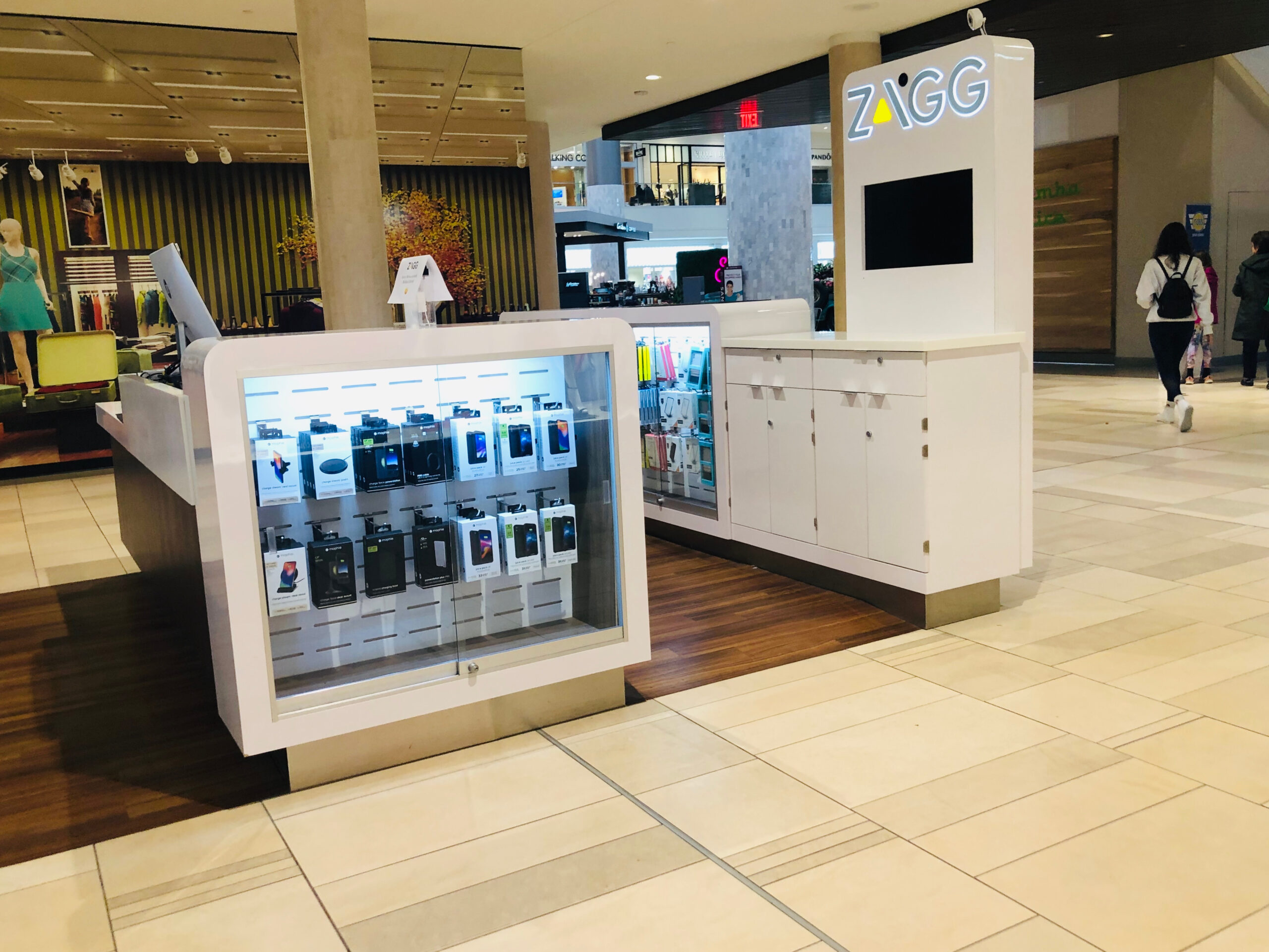How to Start a Mall Cart or Kiosk Business
October 31st 2025
As you walk through your local mall, you might not even notice the small businesses operating in the middle of the aisles. I’m talking about the compact retail booths that typically specialize in one type of product or service and that operate in the common areas of indoor malls. These businesses are where you’ll find a wide selection of cell phone cases, t-shirts, calendars, and trendy toys, as well as skincare products, gourmet popcorn, jewelry, and fuzzy slippers, to name a few popular items.
This isn’t a new business model, but it’s becoming a smart way to test new product ideas without having to commit to a five-year storefront lease and more space than you could fill. In fact, some of the most successful kiosk businesses only open three or four months a year, around the December holidays.
A retail kiosk can be a way to test an idea or build a customer base before investing in pricey retail space, as well as to set up shop permanently.
Mall Kiosks Are Booming
Mall kiosks are actually a growing industry, currently valued at $13.4 billion in the U.S. alone and consisting of more than 63,000 operators, according to IBISWorld. Between 2020 and 2025, kiosk revenue grew at a rate of 3.2 percent annually, with the market as a whole growing as well.
It’s obvious why kiosks would be appealing to business owners—lower overhead costs with all the traffic anchor stores are exposed to, without multi-year commitments. Surprisingly, those compact kiosk spaces can still generate a six or even seven-figure income.
For mall owners, kiosks are a win as well, by bringing in more revenue from space that is typically just a pass-through.
The Kiosk Advantage: Why This Model Works
Starting a mall retail kiosk offers several advantages over traditional brick-and-mortar spaces, making it an ideal testing ground for a new business concept or product line.
Lower Financial Investment
Unlike traditional storefronts or franchises, setting up a mall kiosk business does not take hundreds of thousands of dollars. The average cost of starting a mall kiosk business ranges from $2,000 to $10,000, according to eHopper. For $10,000 or less, you can get your kiosk unit, some inventory, and basic equipment to process payments.
Built-In Customer Traffic
According to Capital One Shopping, in total, American consumers make 1.3 billion monthly shopping center trips and visit malls an average of 5.2 times per month, as of 2024. This is one of the biggest benefits to mall kiosks, which benefit from the foot traffic they didn’t have to pay to attract. Mall customers come to the space with the intention to buy and generally have to walk past kiosks as they move from store to store. This is guaranteed visibility that many other stores may have paid to attract through advertising and promotions.
Impressive Revenue Potential
Despite their smaller footprint, mall kiosks can still generate high sales per square foot. Current estimates of average brick-and-mortar sales per square foot were $325 in 2025, while successful kiosks can generate as much as $1,200-2,500 per square foot, depending on the product and the margins you can earn.
Lease Flexibility
Most malls offer leases of three or six months for kiosks, some even allow month-to-month, rather than the three- to five-year commitments typical of larger retail stores. This flexibility helps newer entrepreneurs avoid making large financial commitments during the market research or startup phase. Sometimes it’s also possible to relocate a kiosk to a different spot within a mall if space becomes available and/or a current location is experiencing disappointing sales.
Kiosks offer flexibility in general, with respect to lease commitment, location, and even product offerings; it’s fairly simple to pivot if one product is underperforming, switching it to something else entirely.
A Kiosk Startup Roadmap
1: Research your inventory carefully
The product you choose to sell will make or break your kiosk. Ideally, you want popular items with a high profit margin.
Research suggests the following are among the most popular product categories:
Electronic accessories and gadgets: Cell phone accessories top the list of common kiosk products because phone designs are constantly changing, and cell phone owners like to swap out cases. Replacing lost chargers is also a regular occurrence for some owners.
Food gifts. Around the holidays, kiosks spring up offering specialty items and bundles such as tea and accessories, popcorn tins, and the old Hickory Farms cheese and cracker packs. Margins aren’t quite as high, but repeat customers can generate solid volume.
Cosmetics and beauty products: Skincare products can offer high demand and high profit, especially as trends such as Korean skincare routines are going strong in 2025. These types of products do well with demonstrations and in-person consultations.
Jewelry and accessories: If you ever had your ears pierced in high school, odds are good you had them done in an in-aisle jewelry kiosk. Jewelry products are popular choices because of the low cost and high demand, since they can appeal to a wide range of customers.
2: Understand Your Costs
Before you go all-in on a kiosk, be sure you’re clear about the financial investment required. Your upfront costs will include, at a minimum:
- Rent for kiosk space: Depending on the size and foot traffic at your local mall, you can expect to spend somewhere between $500 and $10,000 per month. The time of year and your proximity to high traffic areas will also be factors.
- Kiosk structure: Some malls provide the physical unit as part of the monthly fee, while others expect you to. If you have to set up your own mini-store, you can expect it to cost between $2,000 and $20,000 for the physical unit. One of the cheaper formats is a movable cart, which is especially helpful if you want to test out multiple locations.
- Retail equipment: No matter what product you sell, you’re going to need a computer and payment processor at a bare minimum, with lighting, display stands, and signage being other accessories you’ll want to consider. You can pay anywhere from $1,000 to $10,000 for this type of equipment.
- Inventory: You’ll also need to invest in products to stock your kiosk. Depending on the price point you’re targeting, you should expect to spend at least $1,000 to $10,000 for your initial shipment of items.
- Hired help (if needed): Even if you plan to staff your kiosk yourself, you may want to set aside some money for part-time help to give yourself a break during busy weekends.
3: Find a Location
Your location within the mall can make or break your kiosk business. Being situated near an entryway versus hidden away in an obscure corner will dramatically impact your sales. You want as much visibility as you can afford, to be able to catch the eye of as many potential customers as possible as they walk by.
As you evaluate different potential locations within a mall, make sure you study:
- Foot traffic patterns: Not only do you want to estimate traffic numbers, or how many people walk by a certain spot, but you also want to understand how time of day is a factor. The best way to gauge this is to count people walking by at different times of day and days of the week. Find the walkway that is consistently busy and aim to get a spot there.
- Check obstructed views: Just like at the theatre or ball game, you don’t want a seat behind a pillar. Likewise, in the mall, you don’t want your kiosk to be hidden behind a display or column either. People need to be able to see you to buy from you.
- Anchor stores with similar target customers: All things being equal, you’d rather be near a retailer that serves the same customer demographics as you do. Meaning, if your ideal buyer is a young mom, try to get a spot by a children’s clothing store or the restroom. If you serve teen boys, proximity to a video game store is a good bet.
- Find your competition: If you’ll be selling a product that other kiosks already stock, can you get a location on the other side of the mall, so that you won’t necessarily be directly competing with them? Or, after assessing their inventory, can you stock your kiosk with different brands or types, so that you’re competing head-to-head even less?
You may be quoted a bargain basement price to go into a quiet section of the mall, but don’t be enticed. Low traffic means fewer customers, which means lower sales. This is one instance where you’ll want to pay more for a better location.
Next Steps
Given that we’re already in Q4, you may want to consider starting with a temporary or seasonal kiosk lease to test out your concept while conserving cash. See what works and what doesn’t as data for next year, when you may want to get set up right after Labor Day for the busy holiday rush.
With the right product, location, and sales approach, you can build a profitable business that doesn’t require a pricey storefront and massive inventory.



















